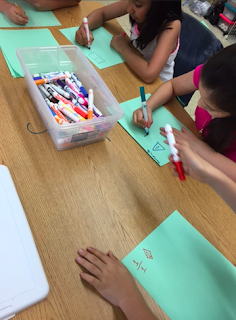Hello and welcome to the next #D100BloggerPD of Michael Fisher's Hacking the Common Core!
If you are just now jumping in, feel free to start with Kristin's kick-off at Reading_and_Owl_of_the_Above!
This post will cover the 9th Hack:
All Size Fits None
Adapt to fit every learner
It is the perfect quote for this chapter because as we know, assessments are only a screenshot of the whole child. To quote my literacy coach, "A child is not a letter, or a number." There is so much more to a student that is not captured in any type of assessment. Michael Fisher offers some great ideas on how to go about this issue.
The Problem: New assessments aren't giving us good data
Fisher begins by explaining that as education changes, some changes are not necessarily for the better. Education reform has moved towards adopting a business model - which loves to quantify data. Because of this, we've had a large push for assessments to give us that data. Some assessments can help teachers to make instructional decisions, but there are others that do not serve that purpose. There are certain assessments whose results do not come back until the following school year. Yet, there is a huge amount of pressure on teachers to ensure student success in these assessments.
Raising test scores is not our objective.
Teaching children is our objective.
Michael Fisher's hack: extraordinary teaching. We have no control over these state mandated assessments, but we do have control over what we do in our classroom. The Common Core does not advocate for standardized testing. When we unpack the standards, we find the exact opposite. The Standards want students doing deep, critical thinking.
As teachers we must focus on this deep, critical thinking by frequently ask students 'Why?" and listen to their answers.
What You Can Do Tomorrow
(I LOVE this, by the way, it has #HiawathaPride written all over it)
- Stop the test prep- Don't stop the real teaching and learning to prepare for tests. Fisher suggests embedding these skills throughout the year.
- Build Relationships- Students wont learn from you if they don't know you, or feel like you care. Period. Know your kiddos.
- Stop having students pulled out of class during learning time- Kids shouldn't miss mini-lessons and new instruction. Schedule pull-outs at times of independent practice times.
My biggest take away from this chapter was Fisher's clear encouragement to teach students in the most authentic way possible. Test prep is not authentic. He also encourages teachers to embed literacy, all domains of literacy, throughout the day - speaking, listening, reading and writing. ALL. THE. TIME. These are valuable skills they'll need to succeed throughout their lives.
Thanks for joining me today and remember to check back on October 25th with Colleen at Literacy Loving Gals for the final hack: Involve Parents.































